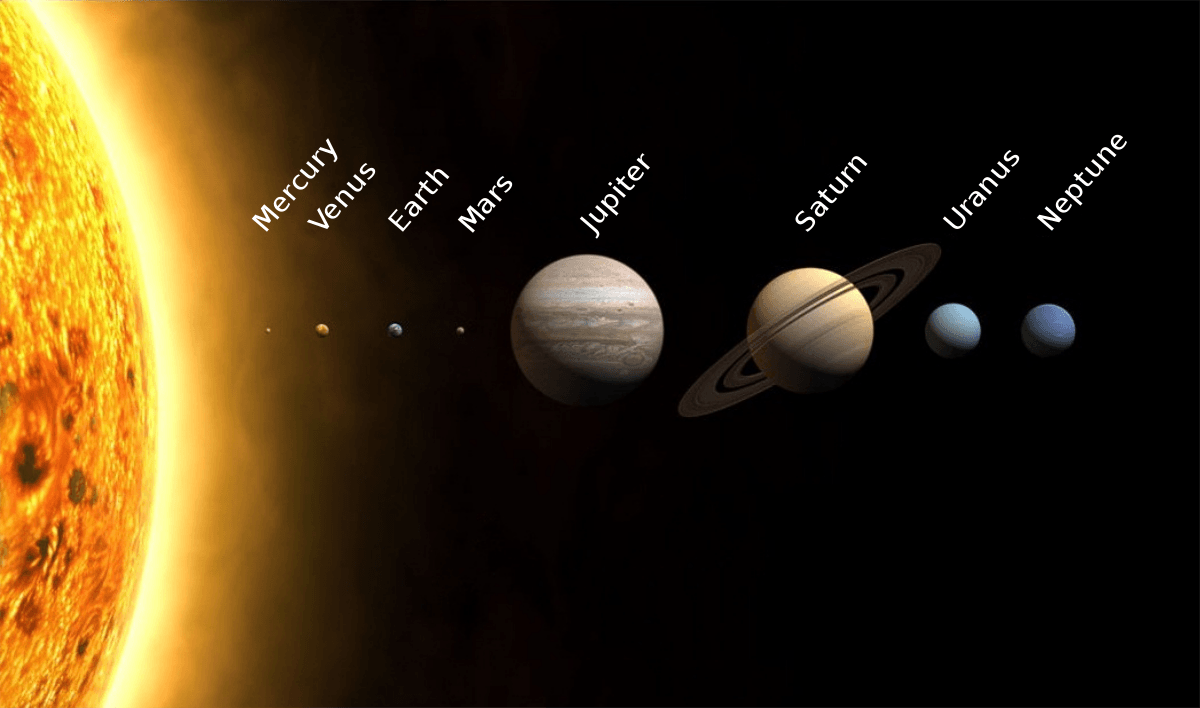
A solar system is a collection of planets, comets, and other orbiting celestial bodies gravitationally bound to a central star. Our sun is the center of a solar system that contains 8 planets. Among these 8 planets are over 180 moons, with the majority centered on the larger planets. In addition to the 8 planets and their respective moons, there is a handful of dwarf planets, comets and asteroids occupying our solar neighborhood.
Our solar system is over 4 billion years old and was formed from the compressed remains of a giant interstellar molecular cloud. The sun was formed through the high heat and pressure of the compressed cloud as it gravitationally collapsed in on itself. The resulting spinning accretion disk flung out clouds of gas and matter that eventually coalesced into the planets in their elliptical orbits. The 4 innermost planets are all small, mostly composed of rock and metals. Earth is included in these 4 terrestrial planets. The 4 outer planets are massive in comparison and are composed primarily of gasses. The first 6 planets have been known to humans since antiquity, while numbers 7 and 8 were discovered only within the last 400 years. Despite having 8 total planets 99% of the mass of the solar system is contained in the sun. Of that 1% not contained in the sun, the majority of that mass is contained in a single planet, Jupiter.
The proverbial “edge” of the solar system is the edge of the heliosphere, the region of space that is affected by solar wind and radiation. According to measurements by the probe Voyage I, the edge of the heliosphere extends out 122 AU (1 AU = 93 million miles, the distance from the Earth to the Sun), about 3 times the distance to Pluto (40 AU). This means that the solar system has an effective radius of about 1 light day.
From 1930 – 2006, Pluto was considered the 9th planet of the solar system. The definition of a planet was formalized in 2005, leading to a new classification scheme that excluded Pluto from the category of planets.
The Planets Of The Solar System (In Order)
Mercury
Mercury is the first planet in the solar system and the closest to the Sun. Mercury orbits its parent star once every 89 days, giving Mercury the shortest solar year of all the planets. It takes Mercury 58 earth days to rotate once on its axis, but the combined side-reel effect due to revolution around the sun gives a single “day ” (sun up to sun down) on Mercury at 176 days! Mercury is named after the Roman variant of the Greek messenger god Hermes
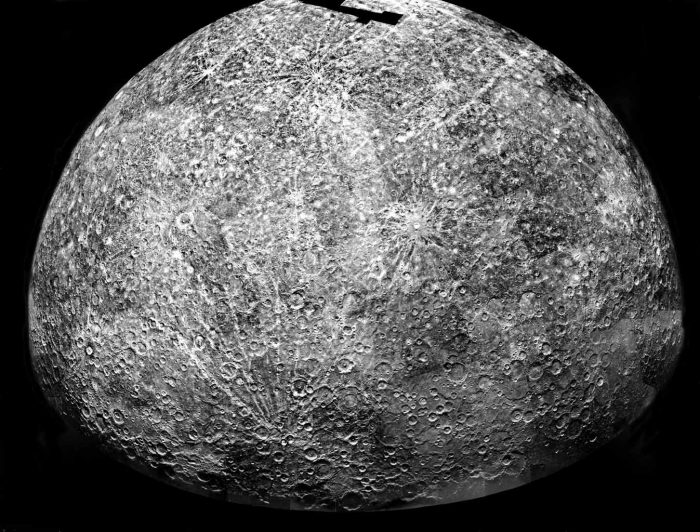
Credit: Nasa.gov
Mercury’s surface is similar in topology to the moon, a dry dusty basin filled with craters from meteor and comet impacts. The temperature on mercury varies widely from a day-time temperature of up to 427 °C and night-time temperatures that reach −173 °C. The wide fluctuation in temperatures is due to Mercury’s lack of a substantial atmosphere. The lack of atmosphere means that can neither reflect heat from the sun or trap heat.
Venus
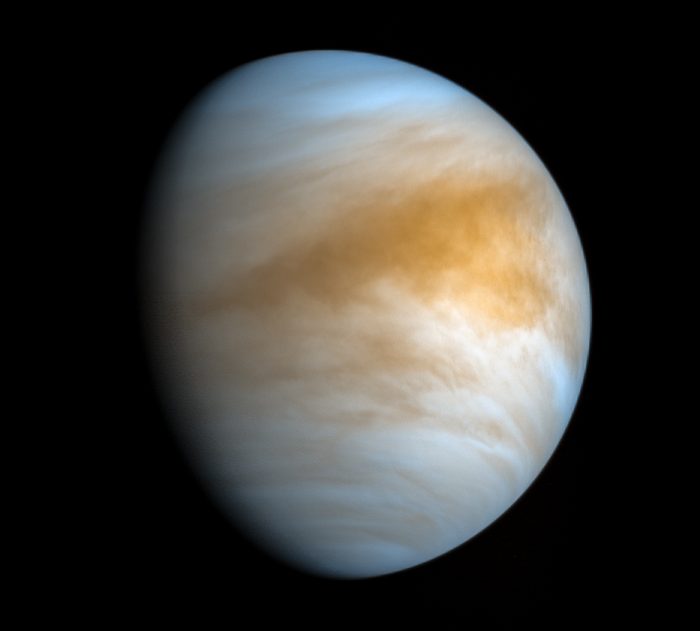
Credit: K Gill via Flickr CC BY 2.0
Venus is often described as Earth’s sister planet, because of the similar size, distance to the sun, orbital period, and mass. However, as the second planet closest to the sun, Venus could not be more different from her lush green sister Earth. Venus has a crushingly dense atmosphere of 96% carbon dioxide, rendering surface temperatures higher than 462 °C and atmospheric pressures equivalent to that of 900m under the Earth’s oceans. The high temperatures are a consequence of the runaway greenhouse gas effect caused by the high concentrations of carbon dioxide in Venus’ atmosphere.
Venus is one of the brightest objects in the sky and for that reason was likely the first planet ever identified by humans as early as 2000 BCE. Historically, it has been referred to as both “the morning star” and “the evening star.” Venus is the closest planet to Earth and has been a target for much observation. The Venusian year is about 224.7 earth days and the Venusian day is equal to 243 Earth days. Venus is named after the Roman equivalent of the Greek goddess of beauty Aphrodite.
Mars
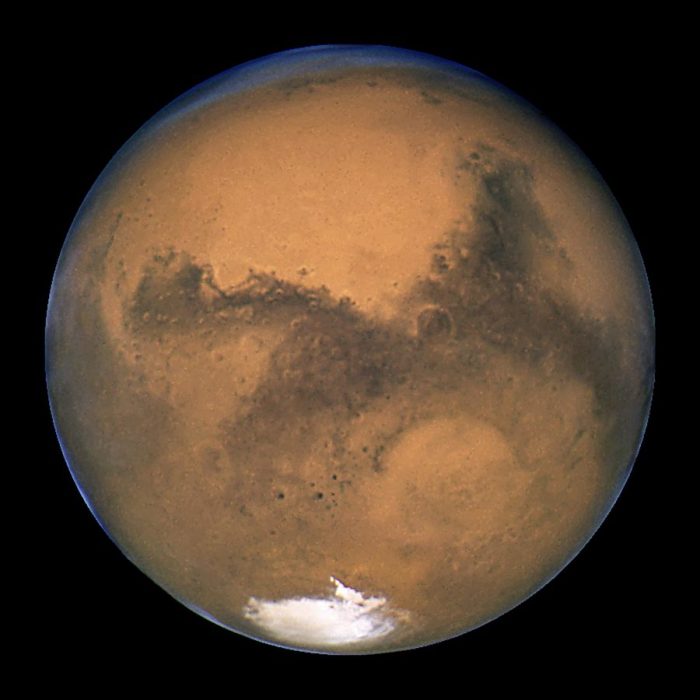
Credit: Nasa.gov
Mars, sometimes called the “Red Planet” in virtue of its reddish appearance, is the 4th planet from the solar system and is the last of the interior terrestrial planets. Mars carries the name for the Roman god of war Mars (Ares in the Greek pantheon). Mars is about 1.5 times the Earth’s distance from the sun and has a mass of about 1/10th the mass of Earth. One day on Mars is almost equal to one day on Earth, while Mars has a solar year of about 2 Earth years (687 days). Mars’ characteristic red color comes from the high concentrations of iron in its soil.
Of all the planets, Mars is the one that has been seriously investigated for having extraterrestrial life or as serving as a potential habitat for humans. Liquid water cannot exist on the surface of Mars, though large quantities of solid water exist in the form of polar ice caps. Very rarely, liquid water deposits can form mixed in the Martian soil. Mars also has the single largest volcano in the solar system; Mount Olympia, which is 2.5 times the height of Mt. Everest on Earth. Mars has two sister moons, known as Phobos and Deimos
Jupiter
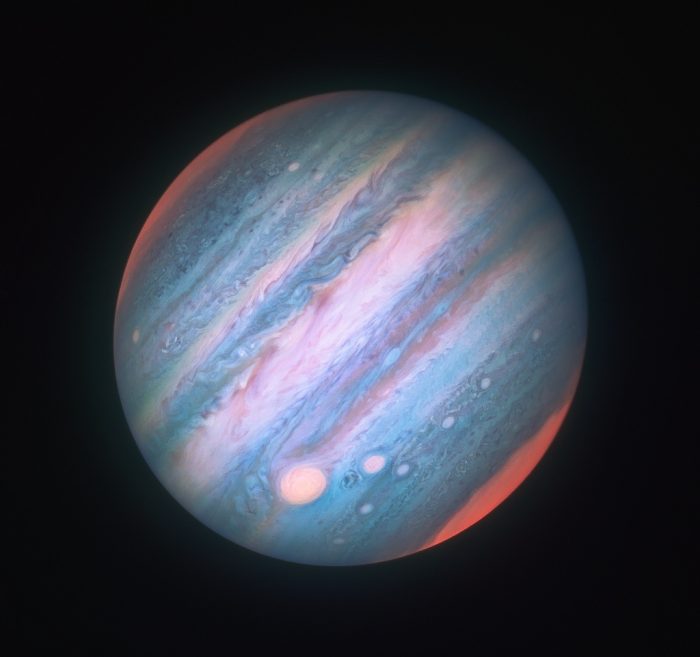
Credit: J. Schmidt via Flickr CC BY 2.0
Jupiter is the largest planet in the solar system and contains the majority of the mass of the planets. Jupiter is the 5th planet from the sun and is the first of the 4 exterior giant planets. Jupiter’s mass is almost 2 ½ times greater than the mass of all the other planets, combined. Jupiter is a gas giant planet in that it is composed mostly of hydrogen and helium. It is named after the Roman god Jupiter (Zeus in Greek). The best-known feature of Jupiter is its Great Red Spot, a perpetual cyclonic storm larger than the Earth that manifests as a glowing red spot south of the equator. A single day on Jupiter is an average 10 Earth hours while a single solar transit is about 12 Earth years.
Despite is incredible mass, Jupiter is less dense than the four terrestrial planets. The relatively low mass to volume ratio of Jupiter has led some researchers to argue that Jupiter was the result of a failed star formation that could not gain enough mass to induce nuclear fusion. Jupiter’s atmosphere is over 75% hydrogen by mass. it is believed that Jupiter’s core consists of an exotic form of liquid metallic hydrogen surrounding a solid core of unknown composition. Jupiter also has the majority of moons in the solar system, at 79. The 4 most well-known are Io, Europa, Ganymede, and Callisto, first discovered by Galileo.
Saturn
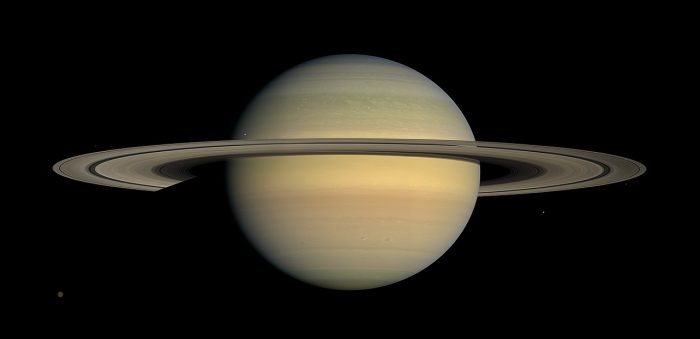
Credit: Nasa.gov
The sixth planet from the sun, Saturn is the second gas giant in the system and the second largest planet. Saturn was the furthest of the planets known to ancient humans and is named after the Roman god of agriculture (Cronos in Greek). As it is a gas giant, Saturn is composed mostly of hydrogen and helium. Its atmosphere has a yellowish tint due to the presence of ammonia in its upper atmosphere. It most likely has a core of iron-nickel rock surrounded by a layer of metallic hydrogen. Though it is very large, Saturn is not dense at all; it would float in a body of water.
The most striking feature of Saturn is its concentric rings that surround the planet. Saturn’s rings are made mostly out of ice, rock, dust and other debris. These rings extend outwards up to 75,000 mi from Saturn’s equator where each ring has an average thickness of 20 m. The cause of these rings is unknown. It is thought that the rings could be the remnants of a destroyed moon, of a leftover result from planetary formation.
Of all the planets in the solar system, Saturn is the only one with a moon that has a substantial atmosphere. Saturn’s moon Titan is the second largest moon in the solar system and has an atmosphere of nitrogen, methane, and ethane. It is the only other body in the solar system besides Earth with clear evidence of stable liquids of its surface (liquid methane). it is believed that Titan may be capable of harboring extraterrestrial life.
Uranus
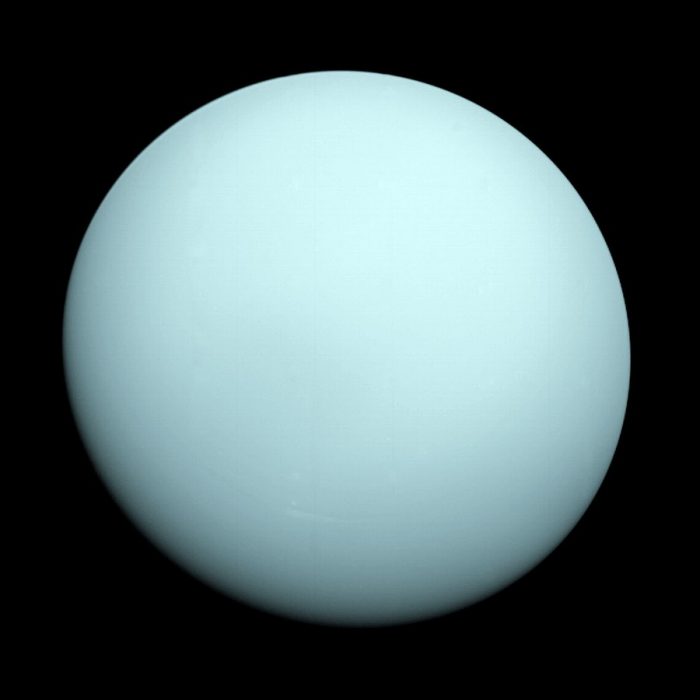
Credit: Nasa.gov
The 7th planet from the solar system Uranus is also the first of the ice giant planets. Uranus is the 4th most massive planet in the solar system and has the coldest atmospheric temperature at −224 °C. Uranus’ atmosphere is composed mostly of hydrogen and helium but has large quantities of water, ammonia, and methane ice. As such, Uranus is often called an ice giant to distinguish it from the gas giants Jupiter and Saturn. Wind speed on the surface of Uranus can reach up to 250 meters per second.
The most distinguishing feature of Uranus is its tilt. Uranus’ axis of rotation is tilted almost 90 degrees so that its poles are near where most planets equators are. As a result, Uranus has seasonal variation unlike any other planet and a different day-night cycle. Uranus had been identified before by ancient societies but was misclassified as a star. It was not formally recognized as a planet until 1783 after William Herschel demonstrated its planetary orbit.
Neptune
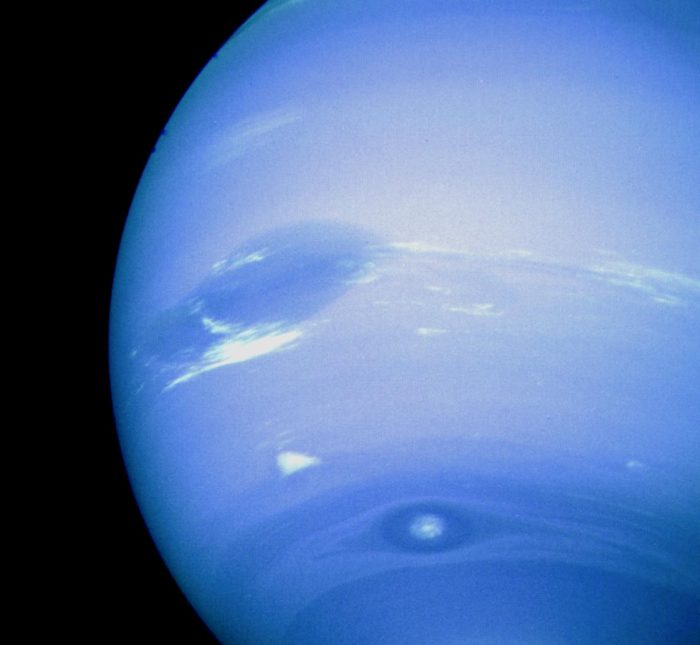
Credit: Nasa.gov
As the 8th and last planet from the solar system, Neptune is the third most massive planet after Jupiter and Saturn, and the furthest from the sun. Neptune is 17 times more massive than Earth and is more massive than its twin ice giant Uranus. Neptune occupies an average distance from the sun of 30 AU (4.5 billion km). Neptune is named after the Roman god of the sea and is the only planet that is not visible from Earth with the naked eye. The existence of Neptune was predicted via mathematical deduction based on gravitational perturbation to Uranus’ orbit and was first observed in 1846 by Johann Galle.
Neptune has an atmosphere made out of hydrogen, helium, nitrogen, ammonia, methane, and trace amounts of hydrocarbons. Surface temperatures on Neptune reach lower than −218 °C and the core of the planet is composed mostly of rocks and ice. Neptune is known for having very large distinguishable weather patterns, that manifests as streaks of color along its blue atmosphere. Neptune is home to massive storms that regularly reach supersonic wind speeds of over 1,300 mph. Neptune has a Great Dark Spot storm system analogous to Jupiter’s Great Red Spot.








